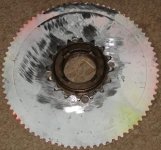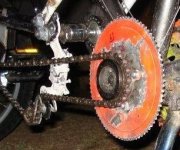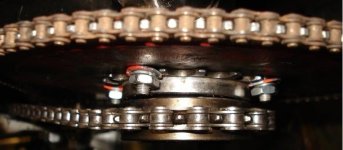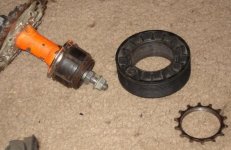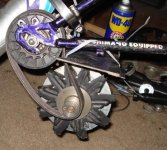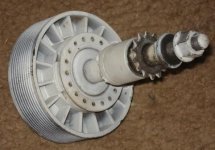REdiculous said:
Sorry, I guess I misunderstood and thought you dropped it cause you had problems..which I thought was the gearing...maybe you should give it a second chance! I'm used to thinking in terms of ratio from motor to wheel. 30:1 from motor to crank means it's not really 30:1 in my mind.

:wink:
That's true, but since mine was variable after that point, I only listed that specific part of the reduction.

The ratio runs in reverse from that point, the same way it does for pedalling, and I suspect you don't want to add that complication to your drive (although it would be more efficient if you could, since you could shift gears for startups vs cruising speed).
So for yours, you could emulate just the second stage of reduction I used, which is the 1/2" chain and 110T wheel sprocket off a dead ScootNGo electric scooter, along with the smallest sprocket that will fit on your treadmill shaft. There are larger 1/2" sprockets around; some VERY large ones are found in stationary exercise machines; I have one that is at least 144T (don't remember exactly--it's the size of a small plate).
To get up to 36v would bring my battery weight near 50lbs unless I totally started over. If I switched to 36v I'd have to re-purpose a $50 battery and $85 controller...the inverter was "free" so I'm not counting it.
I see where that could be a problem. I scavenge and reuse stuff all the time, so am used to the budget issues.

The weight could definitely be a problem; but as long as you are primarily cruising and not in stop-and-go traffic or dealing with hills, it won't affect your range as much as you might expect.
The controller would be useless but the other stuff could go in my kid's tree house I guess. I'm not familiar w/ 36v controllers but I'm assuming I'd need one..I dunno what putting together a new 36v battery (and getting a 36v charger) would run but I could look it up.
Depending on time required to charge, you can use your existing 12V charger to charge all three, either by parallleling them for charge and then switching back to series for riding, or by charging only one at a time without unhooking anything.
If you're willing to use smaller used batteries you could get some from wheelchair/powerchair repair depots. They might have some that still have life but are going to be recycled for whatever reason, that they'd sell really cheap or even give away just so they don't have to pay disposal fees/etc. Often the U1 31Ah size (about 20 pounds or so) and the 17-20Ah size (about 12-15 pounds) are used in such things; I have both types here for projects.
Even at 36v I think I'd still want more than the current 3:1 ratio. Just guessing this time but I think 36v w/ 3:1 would mean it'd be geared for a max of like 48mph. If it were closer to a max of 25mph it would be more realistic. Running the motor well below it's rated voltage would hurt efficiency too.
Probably. I am not sure how much of a problem it is since I have yet to road test the idea (or build a dyno to bench test it). For a better ratio, try the smaller 1/2" chain and sprockets, or a belt drive (which also is less efficient but you can *make* a pulley for some belt types relatively easily, if you cannot find the specific sizes you need to get the right ratio).
I'm not sure the inverter losses will be that bad anyway. When the motor could be using more than 250w (up to 2hp),
I'm sure (from your first post) that you already know, but 2hp is 1500W, not 250w.

I suspect that you are simply saying that when the motor *is* using more than around 250w, such as for acceleration, it could use *up to* 2hp, but I'm not sure. Remember that if your inverter did only lose say, 10%, then it would have to dissipate up to 150w of heat from the inverter itself.
losing even 25w out the inverter isn't very significant. I highly doubt the loss is 25w anyway...I think I could easily use more power running lights than is lost from the inverter/conversions.
Possibly. But it is unlikely that the inverter is 90% efficient under heavy load, so the loss is probably higher than the 10% that 25W represents.
The biggest concerns I have myself with using an inverter to power a motor are that it is one more thing to fail, and that it's failure (even if only a blown fuse) is more likely to occur because of the large surge currents the motor will draw at startup from stop and during heavy acceleration. Fairly hefty currents will also flow during heavy loading during hill climbing, as well. As long as you have an inverter rated for that type of duty, it may not be a problem.
The controller itself can probably handle quite large currents, if it is a heavy-duty SCR controller. They've used low-voltage ones for forklifts for decades.

Does yours also rectify the inverter's 120VAC into at least pulsed DC, or does it just chop off all the negative-going pulses so they don't cause the motor to spin backwards? If it is just chopping, then that's one reason your motor doesn't get the power you are expecting, because it would then only be getting half of the power from the inverter--the rest is essentially being wasted in the controller.
The controller I have is really nice and I like the idea of having the inverter on board...it opens up so many options..on a trailer...I wouldn't dream of it on a bike. I think 36v is out and I'm stuck looking for the perfect gearbox (like everyone else?). take it easy

Hopefully a belt or a smaller chain size will help you find a better ratio.

There are also gearboxes around that might handle the loads with the right ratios in them, possibly in lawn mowers and such, for recycled-parts-reuse, and there are definitely options available in the new parts market (but can be costly).


